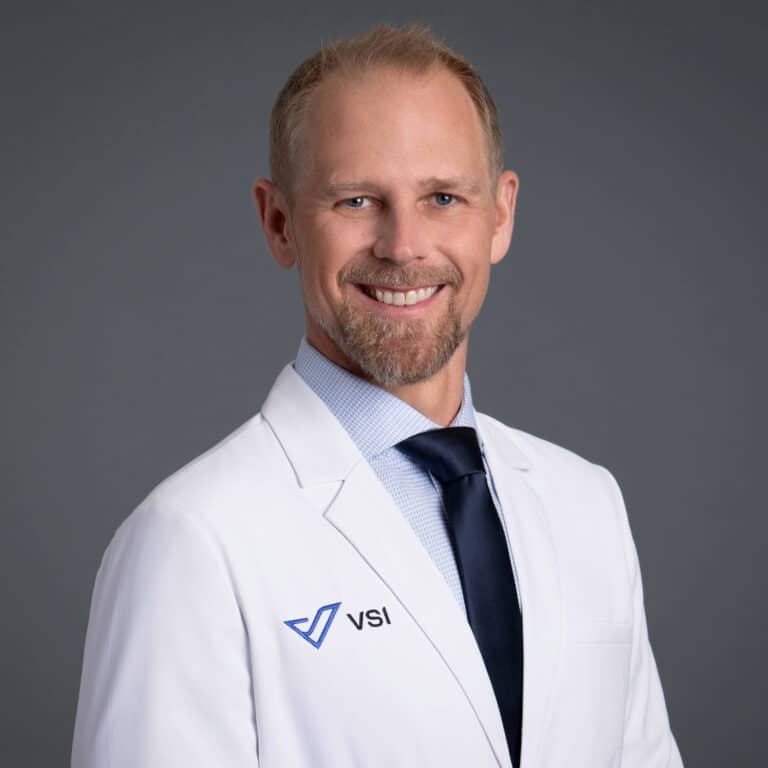
Active Life After Modern Spinal Fusion
Many people have preconceived notions about spinal fusion surgery. Maybe you remember your parents or grandparents having one. If so — you likely think of an open-back surgery with a long recovery time, a lot of pain and restricted movement. But that was then and this is now. In today’s era of modern back surgery, advanced technology makes minimally invasive surgeries possible. That translates to reduced recovery time, less pain and more movement. But what does that look like in real life? Michelle’s story helps illustrate that.
Michelle’s Story
Michelle was super active for a long time — she loves to hike, was running triathlons and was a spin instructor. But eight years ago, pain started to get in the way. She was diagnosed with a bulging disc and had steroid injections and did physical therapy. But it didn’t stop the progression of her pain.
“There just got to be a point where everyday activities just became so burdensome,” Michelle explains. “Anything that required bending forward, and that’s a lot of things, became difficult. Gardening. Yard work. Picking up leaves. Walking my dog and picking up after him. It was all these things in your daily life that for me were being compromised by how I was feeling.”
When pain goes on a long time — it’s not just the physical impacts that take a toll — it’s the mental and emotional ones too. Like many patients, Michelle started experiencing that as well.
“There are people who are older than me who say they’ve been living with back pain all of their lives so I really believed that was going to be me. And I got to the point of thinking — if this is what the rest of my life is like, you know, this is terrible. I wasn’t living the life I wanted to life,” Michelle explains. “I wouldn’t go to social events if I knew I’d have to stand too long or sit too long. I felt 30 years older than my actual age and it felt like my pain was aging me faster than anything else.”
Michelle thankfully found her way to me in September 2022. She had tried non-operative treatments elsewhere — including Platelet-Rich Plasma (PRP), but her pain persisted because she had a collapsed disc. Once that happens — we can’t regenerate it so I suggested a spinal fusion and one level disc replacement. Michelle admits that both she and her mom had a lot of questions about what modern day spinal fusion involves and I told them what I tell all my patients — this is not your grandmother’s spinal fusion. Advancements in modern spinal care have transformed procedures and recovery times. Michelle discovered that in the spring of 2023 when we did the procedure. Right before surgery her mom asked me — ‘Will my daughter still be able to move after that?’ I responded with a question — “How well is she moving now?” “That answer really connected with me,” Michelle later said. “I was already so restricted from pain and I hadn’t really stopped to think about how I’d be able to move or what I’d be able to do if the pain was suddenly gone.”
Listen to the Podcast:
Michelle took about a month to rest and recover and then began to discover what it’s like to live a life without pain. “I feel like every day I’m discovering a new aspect of recovery,” Michelle explains. “I can sit up in bed, which for years I could never do. In fact, I actually spring out of bed and it’s amazing. I joke with people that I’m like Benjamin Button now. I’m aging backwards after the surgery.”
Six months after her procedure, Michelle is working out, doing yoga, walking her dog, traveling, mowing her yard, doing chores and finally running again.
“For four years it was something that I couldn’t do. It felt like my bones were kind of bouncing on top of each other and now I’m back at it,” Michelle says.
She says she also hasn’t taken any pain medicine since her recovery, a real change from the daily Tylenol or ibuprofen she used to rely on to get through the day. Emotionally, she says she’s so much happier too. “Pain can age you physically and mentally and emotionally and I don’t feel that anymore. I feel so grateful. When I hear of other people being in pain, I want to tell them — it doesn’t have to be that way. I know surgery and seeking help can feel scary. But had I known earlier that it was possible to feel like this again, I would have absolutely done it sooner,” Michelle says.
She has some tips for others suffering in pain.
- Do your research. If the first doctor you see can’t help you — search out others.
- Separate spine surgery myths from fact. Understand that modern spine surgery looks very different than what you may remember your grandmother or grandfather getting decades ago.
- Find patient stories — they’re all over social media these days. Michelle says she listened to patient stories in podcasts and videos — searching out people who were her age and were active. She says that helped her understand what recovery could look like. After reading the woman’s success story, she remembers thinking — ‘maybe that could be me.’
- Find doctors and healthcare professionals who will take the time to answer all of your questions. Fear, concern, anxiety — it’s all totally normal. You need and deserve time to ask what you’re worried about and get answers to those questions.
As for Michelle — she’s now planning her next big trip — a 100-mile hike in Europe in 2024. “If my friends would have brought this trip up a year ago, I wouldn’t have thought I could do it. But now I know I can,” she says. “I have a new lease on life now. It’s like I’ve been given a second chance because my body feels the way my mind does. It’s no longer an obstacle. It’s cooperating with me. It’s just amazing.”
Watch the Podcast on Youtube:
Topics covered
About the Author
Featured Resources
Insights to Achieve a Pain-Free Life



